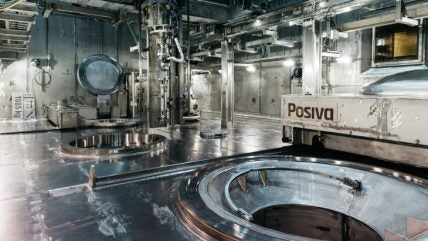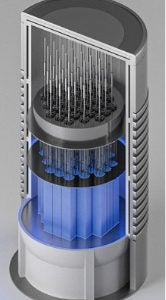
The first stage of encapsulation has been completed as part of the trial operation underway at Posiva’s Onkalo used fuel repository in Finland. The first canister has been packed successfully with test elements simulating actual fuel. The first two encapsulations were carried out using only weights. In this third trial, elements resembling actual fuel, were packed inside the canister.
The trial run is conducted completely under remote control in radiation-shielded facilities. The used nuclear fuel is placed in the final disposal canister made of copper and spheroidal graphite cast iron. This takes place in the fuel handling cell which features concrete walls that are about 1.3 metres thick.
After all the fuel assemblies have been placed in the canister, it is filled with Argon and closed tightly with the inner steel lid. The fuel assemblies are not disassembled. The weight of one fuel assembly is about a quarter of a tonne.
The topmost copper lid of the canister is sealed by friction stir welding in the welding chamber and the leak-tightness of the joint is verified by means of visual as well as eddy current and ultrasound inspections. The sealing joint produced by the selected friction stir welding method has an integrity comparable to that of the canister mantle. The first three canisters have also successfully undergone the welding and machining processes during the trial run.
The encapsulation plant is connected to the underground final disposal repository with a canister lift which transports the canisters down to the underground reception station on the final disposal level at a depth of 430 metres. There they are transferred into the deposition tunnels with the transfer and installation vehicle.
During the trial run, the operation of the final disposal facility is being tested comprehensively, albeit still without the spent fuel. The facility features many unique systems and equipment produced as a result of decades of research and now used together for the first time. The work, which will take several months, is proceeding with the packing and sealing of the fourth canister.
Posiva has been preparing for the disposal of used nuclear fuel for more than 40 years. Its encapsulation plant is located above ground, and the fuel repository of underground disposal facility is located in the bedrock at a depth of approximately 400-430 metres. Posiva has applied for an operating licence to the Ministry of Economic Affairs & Employment and expects to dispose of the used fuel in the facility between 2024 and 2070.
The government will make the final decision on Posiva’s application, after the Radiation and Nuclear Safety Authority (STUK – Säteilyturvakeskus) has given its approval. STUK began its review in May 2022 and the ministry had requested STUK’s opinion by the end of 2023. Earlier this year, STUK asked for the deadline to be extended until the end of 2024 noting that the project was progressing without major problems, but at a slightly slower pace than was previously anticipated.






